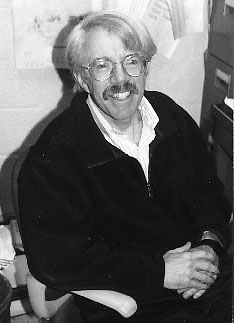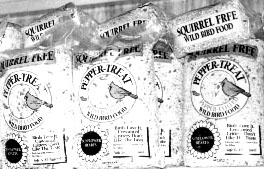
| T H E N I H C A T A L Y S T | M A R C H – A P R I L 1997 |
|
|
|
THE CAPSAICIN STORY:SOME LIKE IT HOT |
by Fran Pollner |
 |
|
Peter Blumberg
|
For Peter Blumberg, coming up with a better birdseed while investigating a compound that acts on neurogenic inflammatory pathways is not serendipity.
"Serendipity suggests that one stumbles on something by chance, but in discovery research, which is the core mission of NIH, one does not simply start with a problem and try to come up with a solution," says Blumberg, an NCI section chief whose group explores the molecular mechanisms of tumor promotion. An integral part of discovery, he says, is recognizing when one's findings represent a solution to a problem that is not on one's list of problems to be solved. A second key element is appreciating that this solution might well be translated into a product—and alerting the Office of Technology Transfer to that possibility.
Blumberg has had frequent interactions with the OTT in the course of his long-term studies of phorbol esters—tumor-promoters derived from medicinal plants in the poinsettia family (Euphorbiaceae) first described in 40 B.C. by Euphorbus, court physician to King Juba II of Mauritania. One structurally related compound, called resiniferatoxin, which proved highly potent in a screening assay (the ability to turn rodent ears red) for this class of tumor promoters, also proved to have a different mechanism of action from others of its class. "Because of its extraordinary potency and our sense that it could not fail to tell us something important about inflammation, we tried to identify its target, and we found that it acted the same way as capsaicin, the hot ingredient in red peppers," Blumberg recalls.
That was the first step in the creation of one of NIH's more unlikely inventions: squirrel-proof birdseed.
The second step emerged during a species-specific hunt for receptors to the capsaicin-like compound: it turned out that mammals had the receptors; birds did not. Voila!
 |
|
Peppery, squirrel-repellent
birdseed adorns the garden-supply shelves at a Hechinger's store in Maryland
|
"As the owner of a horse farm," Blumberg says, "I know the kinds of problems animal people have, and squirrels eating birdseed is one of them." And as a laboratory scientist, he reasoned that birds would eat capsaicin-coated birdseed, blissfully unaware of its fiery qualities, while rapacious squirrels would back off.
Aside from its squirrel-deterring qualities, capasicin is therapeutically interesting, first activating and then desensitizing C-fiber sensory neurons involved in pain perception and neurogenic inflammation. Resiniferatoxin, Blumberg says, acts like capsaicin but preferentially causes desensitization, giving it a "much more attractive spectrum of activity for therapeutic applications," a discovery made early in the course of his group's research.
In fact, birdseed is the subject of but one of the 12 patent applications Blumberg's research has generated, five of which have already been licensed to private industry. Three of these five are related to the clinical development of resinferatoxin and its homologues and have been licensed to a company that is now testing them for clinical use against diabetic neuropathy, postherpetic neuralgia, vasomotor rhinitis (and possibly allergic rhinitis), and urge incontinence. The compounds act as an analgesic against neurogenic pain and also desensitize hypersensitive nerve pathways that disrupt bladder function.
Potential clinical applications in the care of cancer patients are numerous, including reducing the discomfort of cancer-drug–induced mucositis, cystitis, and emesis; and relieving postmastectomy and other surgically induced neuropathic pain.
Blumberg feels technology transfer of his inventions has worked very well, reaping royalties for NIH and the inventor from the time of issuance of a license, even before any products are commercialized. (In the case of the birdseed, which is already on store shelves, the patent is still pending.) He also feels product development is better left to the private sector. His birdseed was licensed to a former postdoc who founded a company "specifically to license and exploit this government invention." Similarly, the company that licensed the other patents was formed by "scientists with entrepreneurial interests, one of whose principals had been at NIH years earlier, was an authority on capsaicin, read our first publication describing the spectrum of resiniferatoxin activity, and recognized, as we had, the exciting therapeutic possibilities. Both of these are examples of the spinoffs of government research leading to initiatives in the private sector."
Commercialization of his discoveries has not altered Blumberg's own career and research choices. "I came here because I thought the opportunities for doing researtch at NIH were even more exciting than the obviously very good opportunities I had had at Harvard Medical School. NCI is the foremost institution in the world for cancer research, and, so far, I've been able to afford to remain here."
Nor have royalties altered his standard of living. "It's really not very significant," he says. "I've earned $24,000 in royalties over the total number of years I've been here, since 1981. So this is not going to buy me too many horses.
"On the other hand,"
he adds, "a lot of these patents are still in the early stages of development."
![]()